Honoring Our Legacy
By Alex Quade
War Reporter & Honorary SFA Natl. Lifetime Member
(Author’s disclosure: MG Eldon Bargewell, Hon. Noel Koch, COL Sully de Fontaine, etc., began introducing this reporter to OSS & SF Originals, more than 15-year-ago. While this piece focuses on four Originals, a list at the end includes others who were a privilege to interview over the years. It’s been an honor to spend time with, and learn from, these men and their families — many, who’ve become friends.)
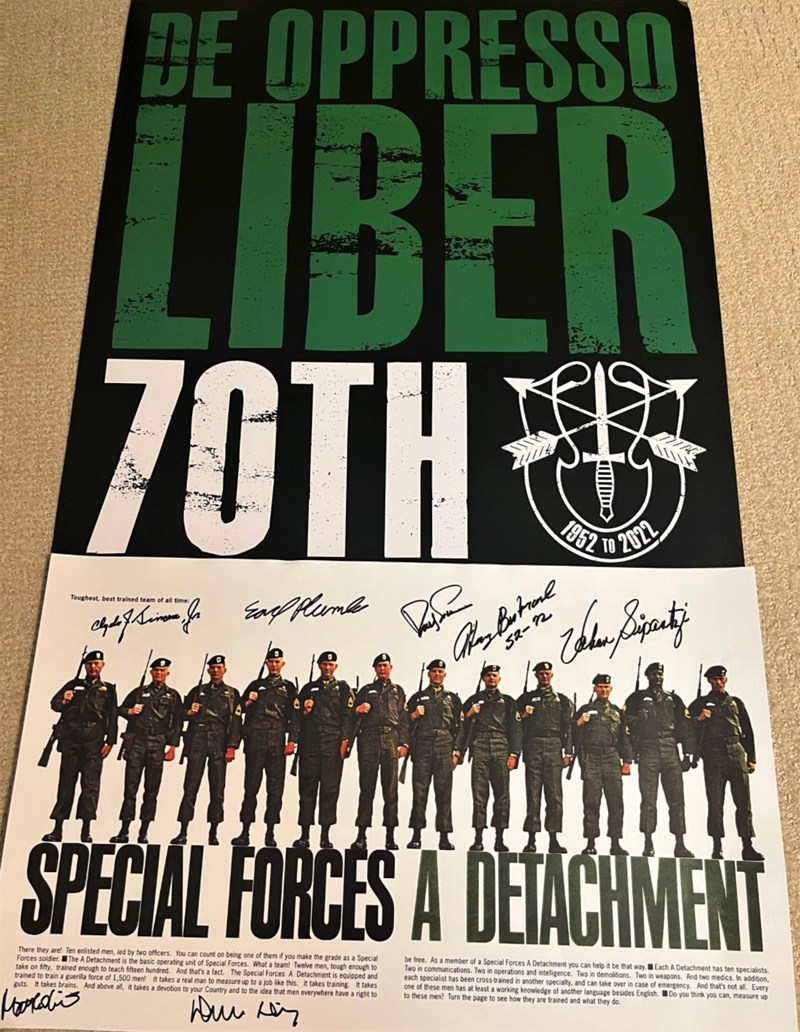
Vintage ODA poster autographed for Alex Quade by SF Originals MAJ (ret) Clyde Sincere, SSG (ret) Richard Simonian, 1SG (ret) Henry Bertrand, COL (ret) Vahan Sipantzi and SF MOH Recipients MSG Earl Plumlee, SGM Matt Williams, and MAJ Drew Dix (Photo courtesy Alex Quade)
Rockstars of the Regiment topped the marquee — packed the house — and turned Generals into gushing fanboys.
“I feel like a kid in a candy shop,” LG Jon Braga, USASOC CG, said of the Special Forces Originals headlining SFACON 2022, in Colorado Springs, CO.
“Honored and humbled to be here… a remarkable legacy of 7-decades of unparalleled service,” former CG USASOC, LG (ret) Ken Tovo, praised.
“It says a lot about the importance of this event that you’ve got the folks here you do: General Pat Roberson (MG Pat Roberson, DCG, USASOC), General Ken Tovo, General Braga, CWO Bob Davis, Command Warrant Officer, USASOC…” BG Gil Ferguson, DCG 1ST SF Command, raved. “Standing room only.”
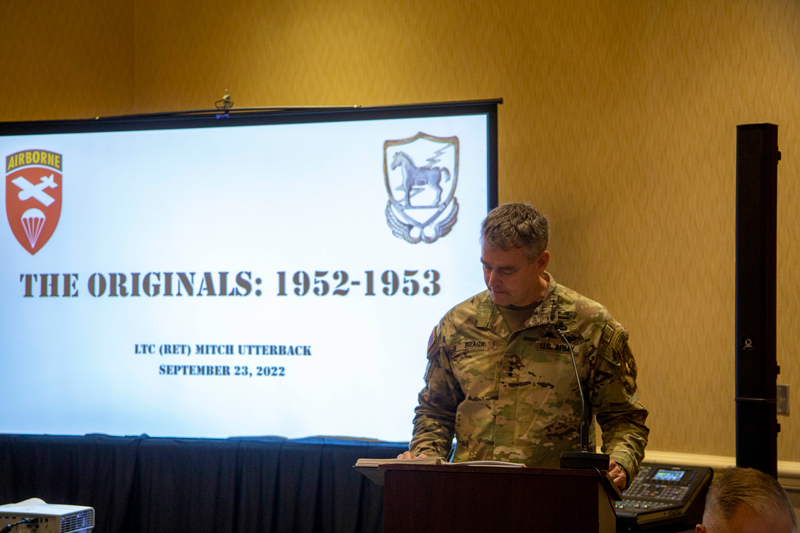
USASOC CG LTG Jon Braga introduces the Originals panel. (Photo courtesy SSG Travis Fontaine)
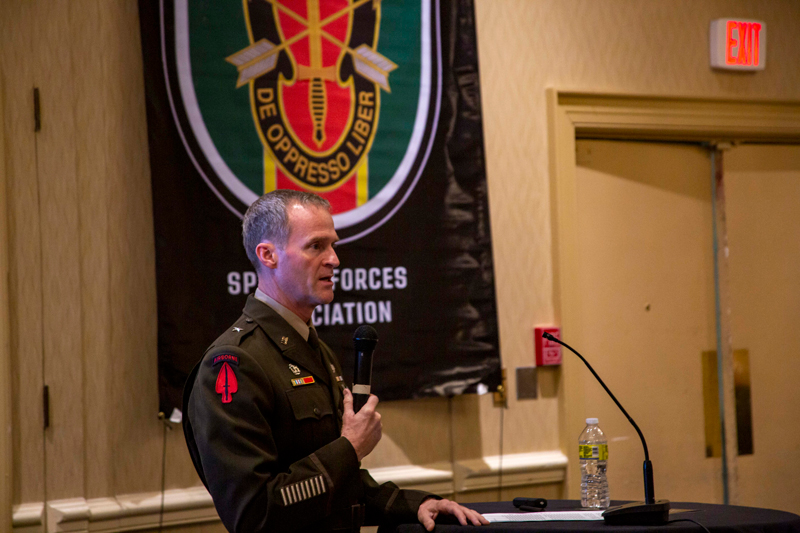
BG GiI Ferguson, DCG 1st SFC, speaks at SFACON. (Photo courtesy SSG Travis Fontaine)
“I know I am just the warm-up act, and this is the real show, right here,” LG Braga effused, by way of introducing the Originals Panel. “This is what inspired me to go into special operations… I never thought I’d get this opportunity to actually interact and listen to some of the actual Originals. Never even dreamt that, when I was a young adolescent reading all these war books, and stuff like that,” he added.
The generals’ idols — COL (ret) Vahan Sipantzi, MAJ (ret) Clyde Sincere, 1SG (ret) Henry Bertrand and former SSG Richard Simonian — did NOT disappoint. The four men in their 80’s and 90’s — kept the audience glued to their every word.
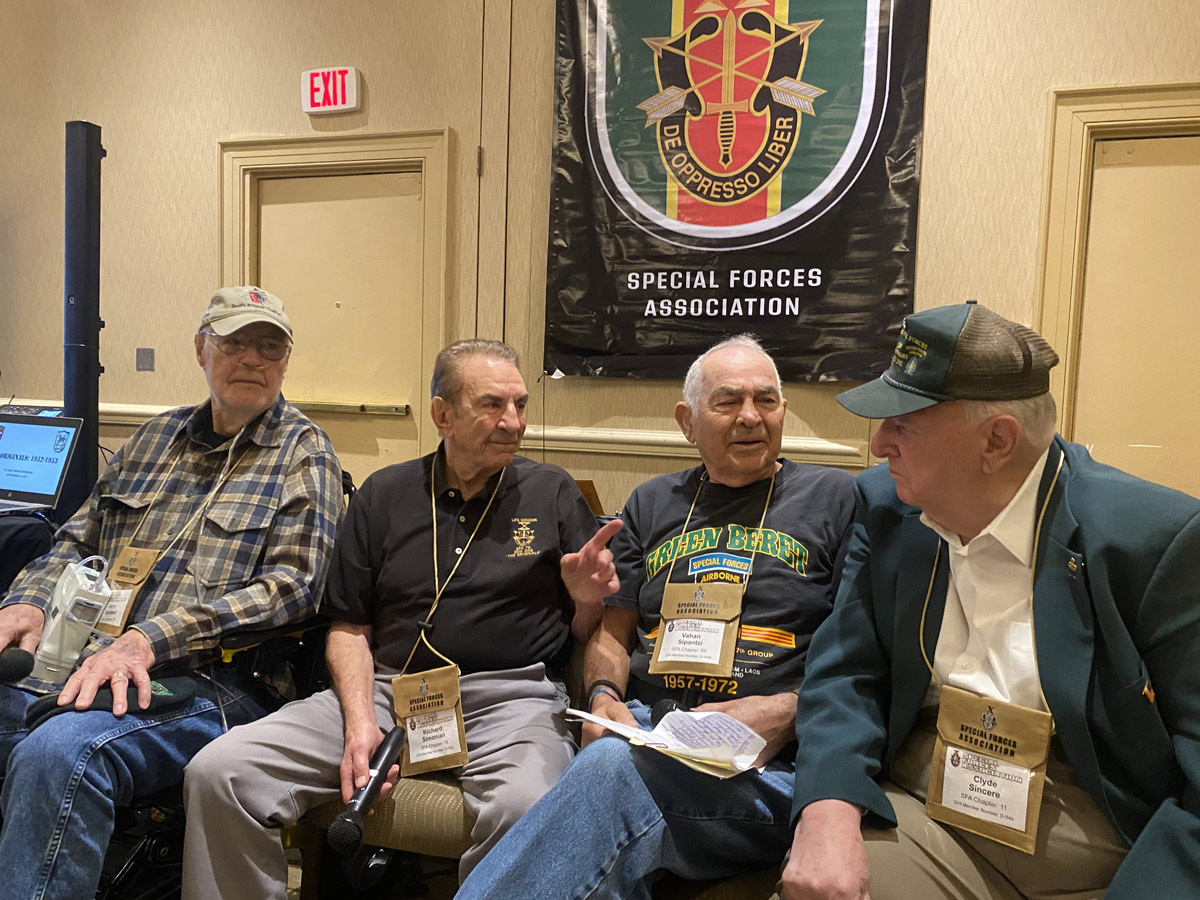
Left to right, the SF Originals Panel — Henry Bertrand, Richard SImonian, Vahan Sipantzi, Clyde Sincere. (Photo courtesy Alex Quade)
“Eventually, I found out it was a new organization. All he’d (the recruiter) said was, ‘It’s the 10th Group.’ There was no indication of anything else,” SF Original Henry Bertrand began. He’d been bused to the 82nd ABN Replacement Company at Ft. Bragg after completing jump school at Ft. Benning.
“I’m sitting around with my duffel bag, and we’re waiting and waiting. I go outside, and there’s this guy walking up and down the street, in front of the building. He said, ‘Hey, are you Bertrand?’ And I said, ‘Yes, I am.’ He says, ‘Well, get in the vehicle, and we’ll take you over to Smoke Bomb Hill’,” Henry Bertrand explained. “Well, the vehicle was a sedan. And I’m thinking, I’m a PFC — and they sent a sedan to pick me up… Man, this is my kind of organization!”
SF Original Richard Simonian agreed.
“The Korean War was already going at that time. I didn’t want to (get drafted to) go to Korea, so I volunteered to join the Army, and volunteered for Airborne and went to Ft. Ord. Two sergeants gave us a presentation about joining a unit that they could not tell me anything about. There was no names, no numbers. All they said was, ‘We can guarantee you will be a Sergeant,’ so I raised my hand,” Richard chuckled, “Promised something good!”
If the generals in the audience expected this to be the de rigueur, academic retelling of hallowed SF history — they were in for a slightly raucous surprise… which I got a sense of while chatting with the Originals prior to the panel…
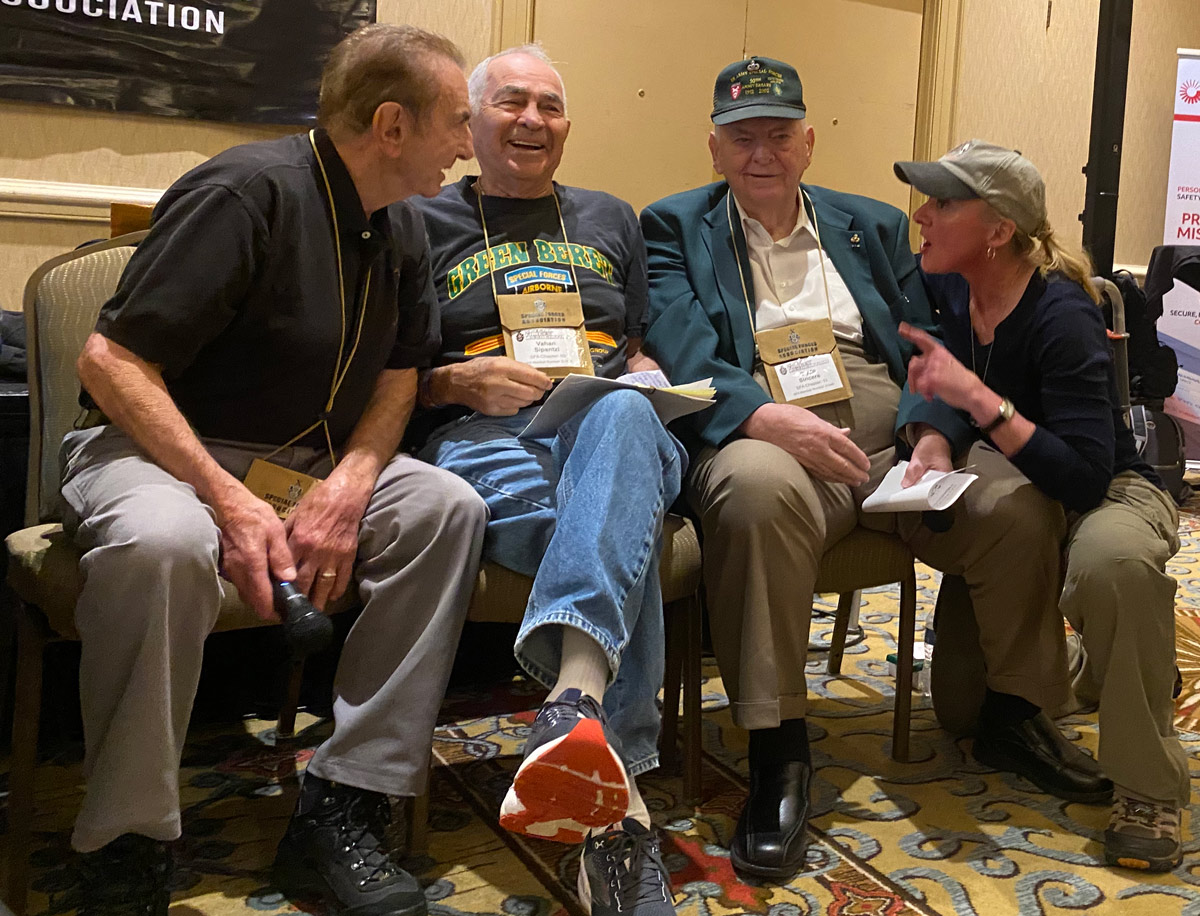
Left to right, SF Originals Richard Simonian, Vahan Sipantzi, Clyde Sincere enjoy Alex Quade's quick questions. (Photo Courtesy Zeke Lloyd)
“I don’t know who that guy is — with the hair,” Original Vahan Sipantzi pointed at the black-and-white photo in the convention poster.
“Well, we all get a little older,” I laughed, thinking he was being coy.
“No — that guy in the photo — it’s not me. Don’t know who that guy is,” Vahan stated.
“Ooops!” I smiled at an organizer’s oversight. (*He and his wife Ms. Zoe, kindly sent me the black and white photo from his scrapbook, you’re seeing here, in the Sentinel.)
“You know, it was an Army Circular basically stating, that a new unit was forming at Ft. Bragg — and the losing unit cannot stop you, if the 10th Group accepts you,” Original Clyde Sincere told me and the men seated next to him, as they quickly — and competitively — compared memories before the panel started. (*Which you can see, in the photo above, of their animated interaction and facial expressions.)
“If they accepted you, we ended up at Smoke Bomb Hill,” one of them immediately chimed in.
“Any idea what all y’all were in for?” I asked them, before sneaking to the back of the full house.
“No, not at the time,” Clyde Sincere replied. This sentiment — echoed throughout the official session.
“They also taught (us) how to procure prostitutes – because they expected (we’d) possibly need that.”
Original and Chaplain, Vahan Sipantzi
At Smoke Bomb Hill, they told the audience, they could choose their MOS…
“They brought us into this classroom and asked us, basically, what we’d like to be in Special Forces. A 1LT was asking the questions,” Original Henry Bertrand explained. “He said, ‘Would you like to be an engineer?’ And I said, ‘Where’s that?’ He said, ‘That’s at ‘Ft. Belvoir.’ Or, ‘Would you like to be a weapons man?’ And so on. ‘Would you like to be a medic?’ I said, ‘Where is that located?’ And he said, ‘San Antonio, Texas.’ I said, ‘I’ve never been to Texas before – I think I’ll become a medic’.”
“There was one orderly room, one barracks, and then, from then on, the detachment started forming,” Original Clyde Sincere said.
(“In the beginning, it was a classroom environment,” Clyde shared with me earlier, “We listened to lectures on Unconventional Warfare from folks that had served in the OSS – Captains Jack Hemingway and Herbie Brucker. Jack, by the way, was the son of Ernest Hemingway. We used to query him a lot on his father.”
“We used to ask him a lot about his Dad. Jack Hemingway and a few other guys were getting all the equipment that we needed — limpet mines from the Brits, Fairburn knives, and a variety of other things,” Vahan added.)
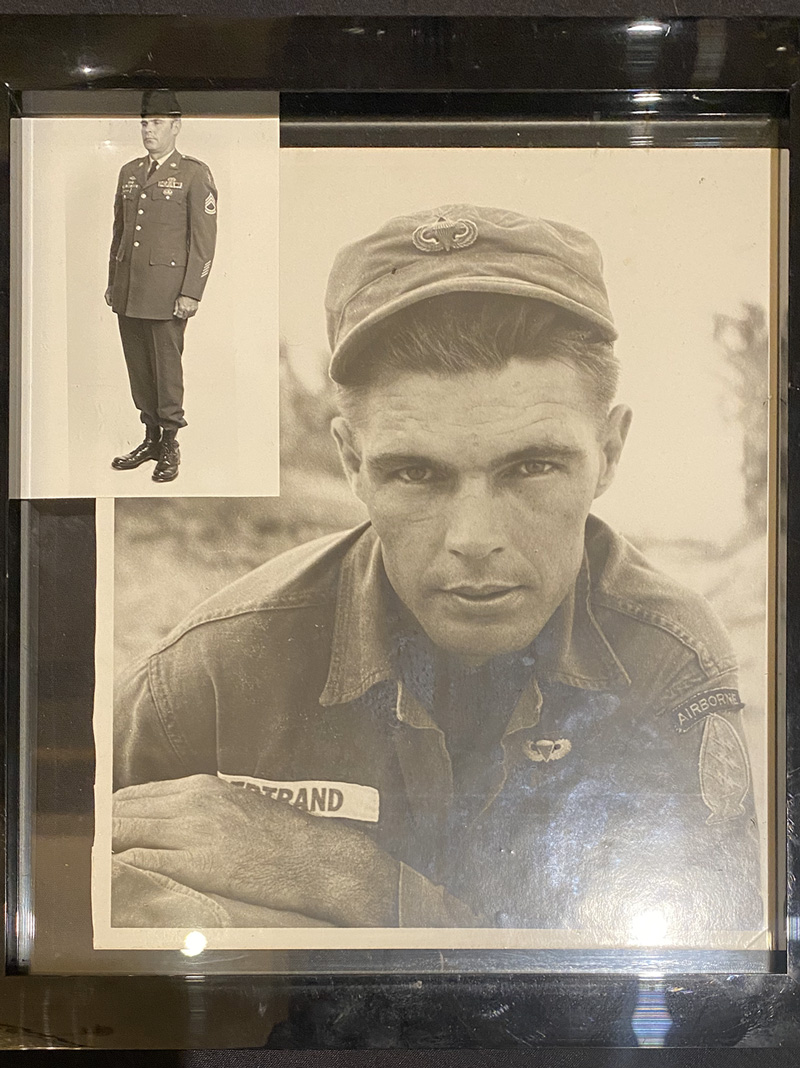
Photos of a young SF Original Henry Bertrand (Courtesy Alex Quade)
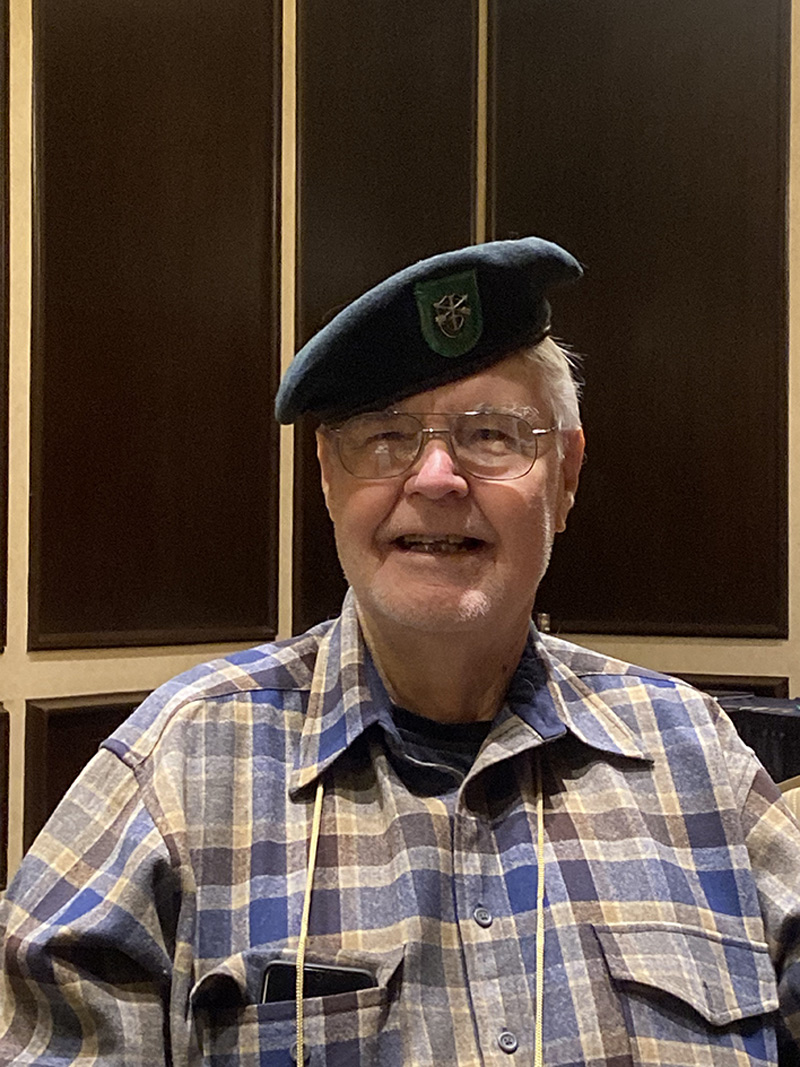
SF Original 1SG (r) Henry Bertrand answers Alex Quade’s questions after Panel. (Courtesy Alex Quade)
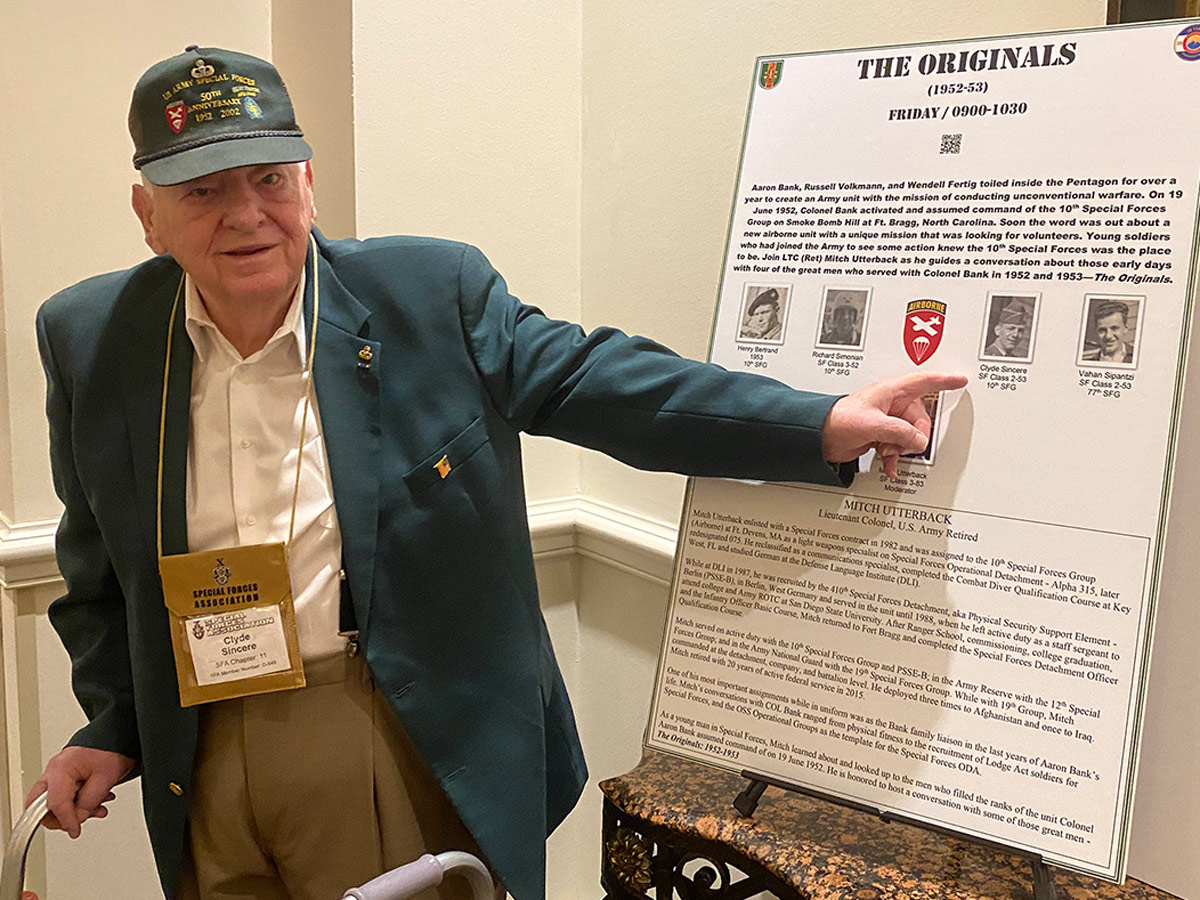
SF Original MAJ (r) Clyde Sincere points out his photo on poster to Alex Quade, while answering her questions before the panel. (Courtesy Alex Quade)
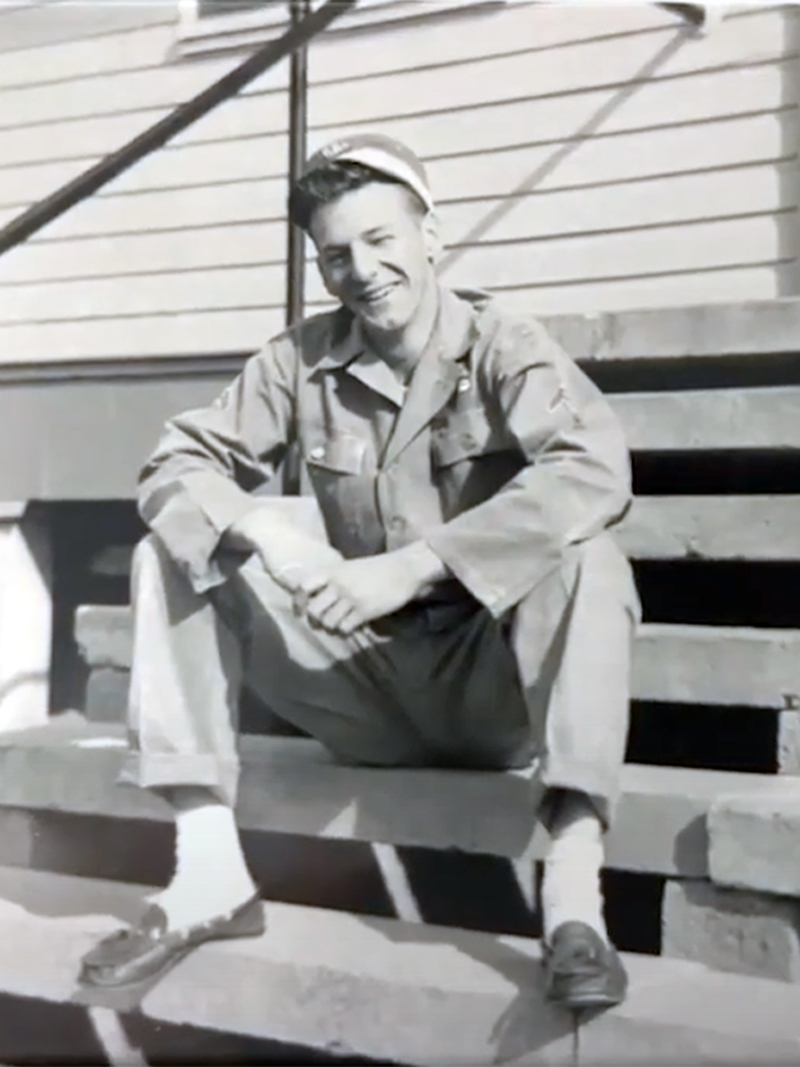
Young SGT Clyde Sincere. (Courtesy 10th Group PAO)
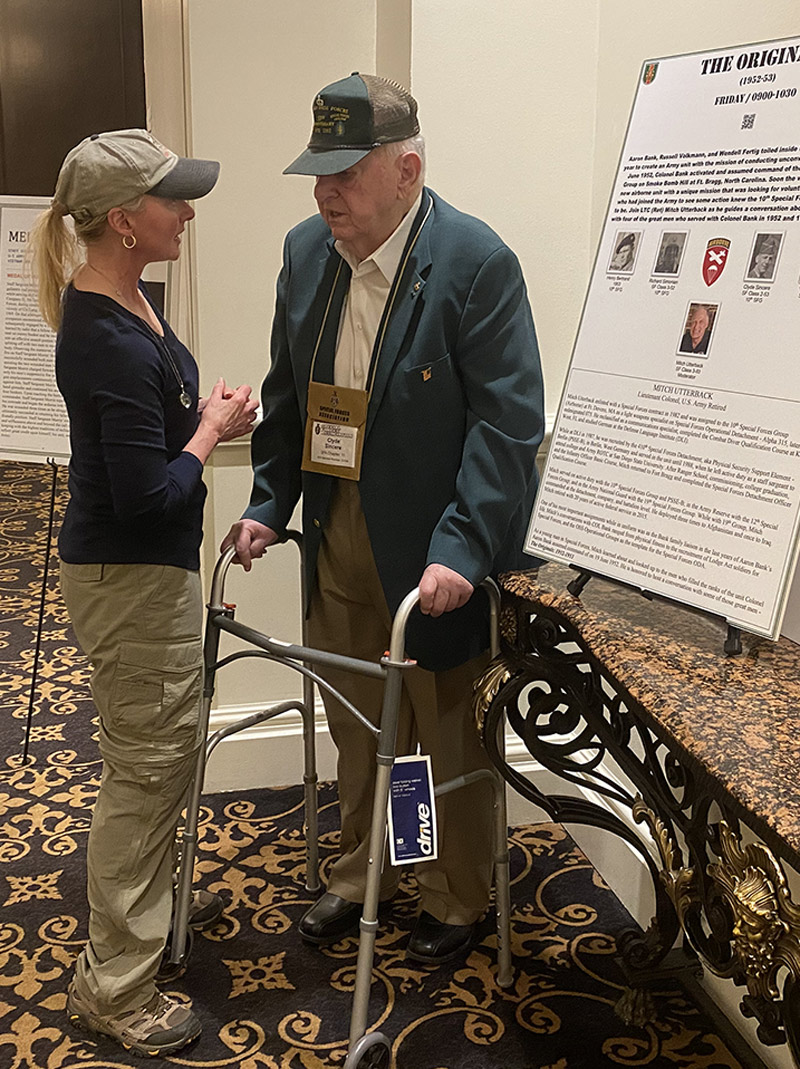
Original MAJ (r) Clyde Sincere shares SF history with Alex Quade. (Courtesy Zeke Lloyd)
Training and language lessons began…
“The first thing we learned in German class was, ‘Ich liebe dich!’ (I love you),” Original Richard Simonian said.
“They also taught (us) how to procure prostitutes – because they expected (we’d) possibly need that,” Original and Chaplain, Vahan Sipantzi shared. “So yeah, well being a young Christian lad that, you know, was reading his Bible and kneeling at his bunk to say his prayers — I remember that. Not to mention the fact that I was engaged at the time.”
That wasn’t the only — unusual — skill they acquired…
“We learned to pick locks… some guys got in trouble with that, in town. We also learned to do forgeries. I forged my own discharge papers,” Sipantzi, the Man of God, confessed.
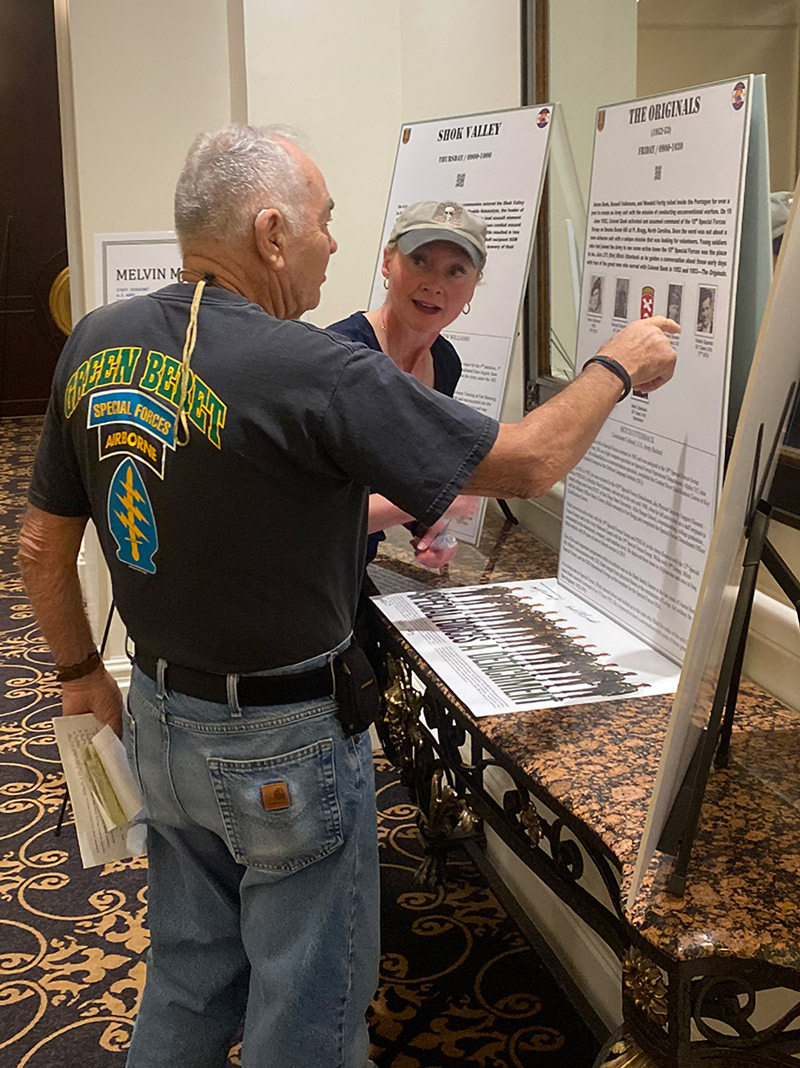
While chatting before the panel, SF Original COL (r) Vahan Sipantzi points out incorrect photo of him on the convention poster. (Courtesy Zeke Lloyd)
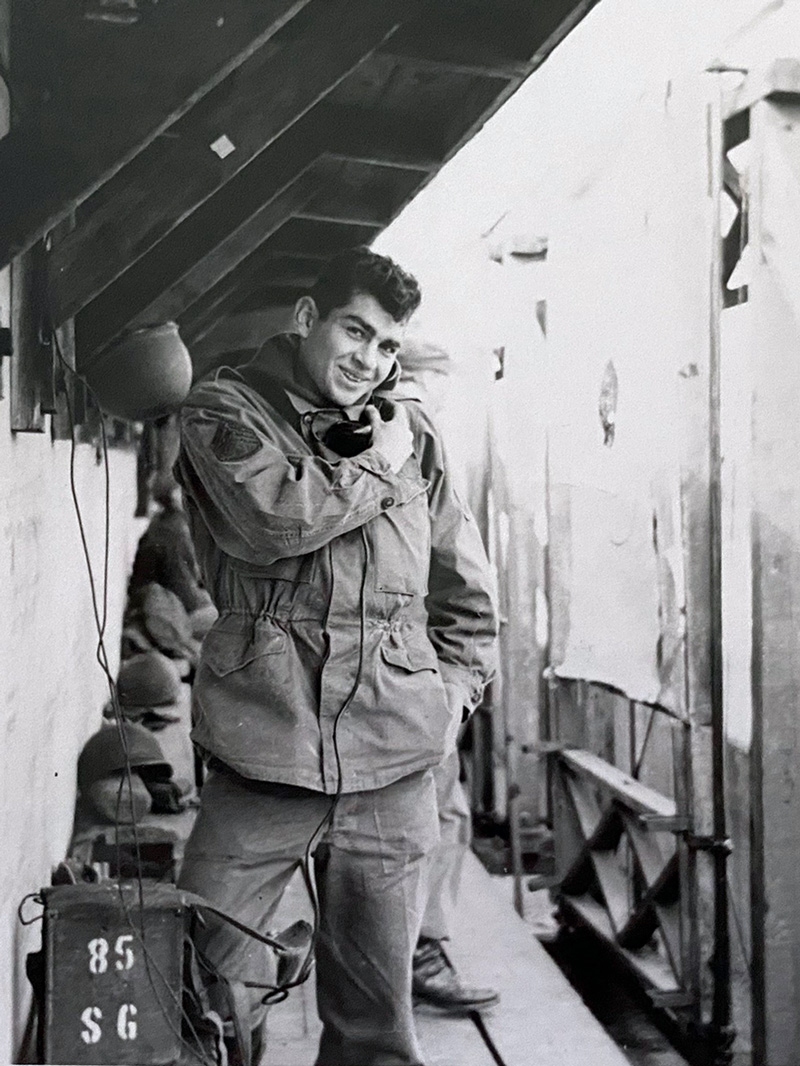
The correct black-and-white photo of SF Original Vahan Sipantzi, 1952. (Courtesy Vahan Sipantzi)
They didn’t always know what each other was doing, nor where…
“My Team Sergeant disappeared for 10 days. And I’m thinking, ‘Where did he go?’ Original Henry Bertrand said. “Well, I never knew, because he wouldn’t talk about it. Until I saw this magazine. And there he is, in a Smoke Jumper outfit in Missoula, MT! They sent a bunch of senior NCOs to go through that course. And, that’s how I found out about that.”
From the sky — to the sea…
“They took us to Little Creek, VA, and they put us on submarine called the USS Sealion for amphibious training. So, they would take us out in the submarine and they would blow that submarine noise, and we’d all get out of the submarine and jump into 12-man rafts and try to row ashore,” Original Richard Simonian explained — admitting they all kept falling into the water. “So, it took us 3-weeks to complete that training. But those guys ate good in that submarine — I’ll tell you that! We traded Jump Wings for their Dolphins,” he laughed.
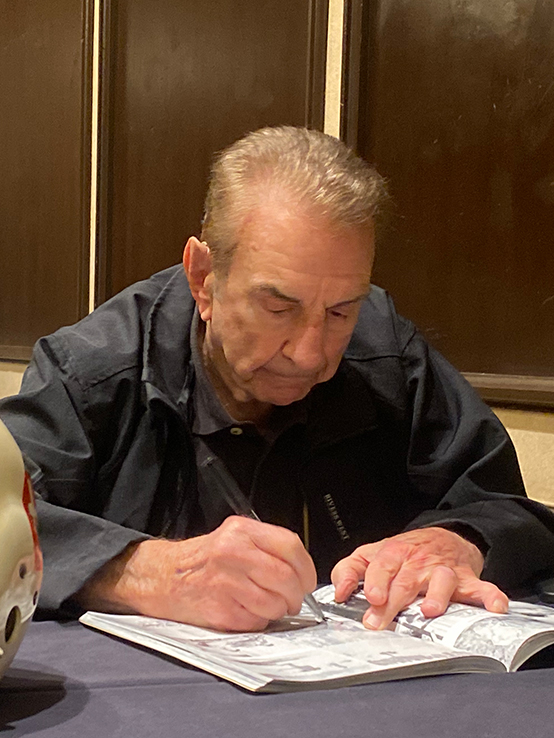
Original Richard Simonian autographing at the SFA Convention.
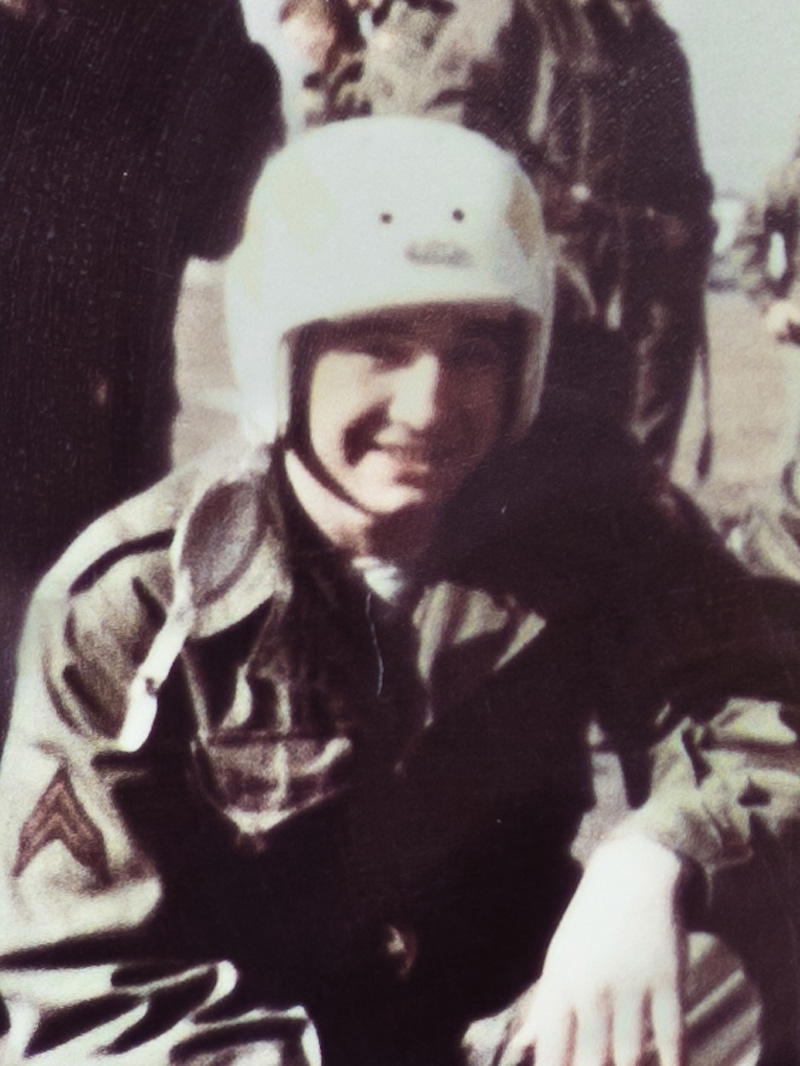
SF Original Richard Simonian, before a parachute jump at Ft. Bragg in 1953. (Courtesy Richard Simonian)
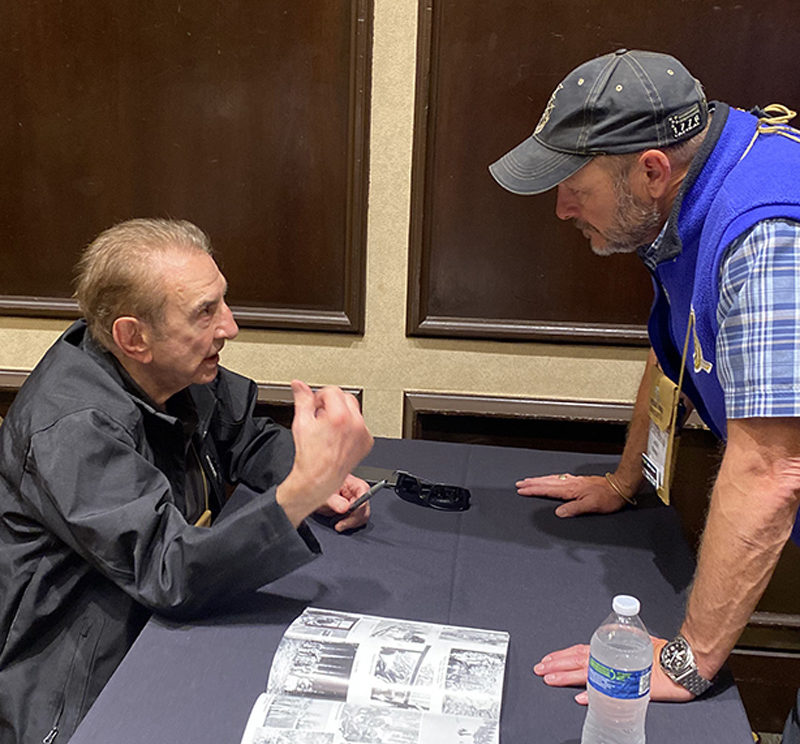
Richard Simonian talks with Convention Organizer LTC (r) John Kress. (Courtesy Alex Quade)
They did not “eat good” — during mountain training with muleskinners…
“You had one duffel bag that you put in whatever you wanted the muleskinners (aka, mule-drivers, or muleteers) to bring in for you, that you didn’t have to pack in. So, I had 10 pounds of potatoes — because I loved raw potatoes. And we left those with the muleskinners,” Original Vahan Sipantzi began.
They were at Gannett Peak, WY, sleeping on the glacier, laced-up in their mummy bags…
“One of the guys woke up — he felt some sort of hot, unusual breath. It was a big bull moose looking down on him. I’m not sure if he used the sleeping bag again after that,” Vahan laughed.
As if the soiled fart-sack wasn’t tragedy enough — their prized potatoes were gone…
“The muleskinners never brought our bags up. And when we got back to where our bags were, we found they had slipped them open and taken out our stuff. The officers literally had to hold us back. Because whatever personal weapons that we carried — because we all carried one in those days, they trusted us with that — but, we had them out and we were ready for retribution,” Chaplain Sipantzi laughed.
Their fight mentality — honed during 4-hours a day of hand-to-hand combat skills…
(Vahan told me earlier just how intense that training was, after I shared with him about MOH COL Roger Donlon and COL Aaron Bank’s knife.
“He was showing me the Aaron Bank’s technique, or method of stealthily employing a knife between the rib cage to effect maximum damage. Is that a polite way of saying it?” I asked the Original (see “MOH Col. Roger Donlon’s Knife Lesson With Alex Quade” on YouTube).
“Oh yeah, because I got stabbed that way. One of the guys — we were doing a 2-man kill — and he came over. I grabbed the guy and you know, put my knife into his ribs. And what you did is, you shove that in the kidneys, and then you dropped down on the handle — so in other words, it made an upward cut right through everything. And then we had a look over the top of the guy, and went right to the target, and he stabbed me in my leg. Yeah, so that’s one of the few times that I got stabbed,” Vahan Sipantzi said.)
Just think… today’s Special Forces could’ve been known as “The Maroon Berets.”
“Wherever we went, they (instructors, former OSS) brought out a sign chalkboard. It said, ‘When in doubt, punt!’”
Translation — kick them in the groin.
“The problem is, my future wife found out about that — and, so, it made it difficult sometimes to sleep at night, when things were not going well,” the Original chuckled.
There were stories about sailing to Bremerhaven, Germany, on the USS Greely…
“Richard was a PFC, so we made him do KP the whole trip,” Original Clyde Sincere said.
(Years ago, when I’d interviewed Richard Simonian and the other Originals, I learned he “got them back for making him do KP duty onboard the ship — by running poker games and taking their money.”
“The poker was in Bad Tolz in the basement, Richard told me. “I ran a dice game where I cut Acey-deucey — cutting 5% on poker and making a lot of money. The wife of one of the guys losing his shirt — called the CO — who told me to stop, because he didn’t want to deal with wives calling him.”
Turns out, Richard — the future businessman — was also running pool tables on the 3rd floor of Tolz.)
There were stories about the train ride to “the Kaserne” (Hitler’s former SS Officer’s Academy)…
“It took 3-days to get there,” Original Richard Simonian said.
(In earlier interviews, I’d heard amusing stories of prostitutes in a train that was next to theirs, at one point in the journey — “They knew we were American soldiers, and called out to us through the windows.”)
There were stories about their time at the Kaserne…
“The local Germans were amused by us. The best times were spent drinking beer in the German Gasthaus. However, German beer took a toll on many of our men who could not, or chose not to remember that German beer alcohol content was much higher than in CONUS,” Clyde Sincere recalled.
(In my previous interviews, stories from the Kaserne ranged from bicycle races in the hallway on the 2nd floor — to classes on SMOE, surreptitious method of entry… from learning to mine dams — to learning to drive or “re-route” locomotives, which were steam engines at the time, requiring teammates to shovel coal.)
“You have to understand that once you put that green beret on, that you actually wear it for life, whether you’re in service or out of service.”
Original Henry Bertrand
And, there were stories about COL Aaron Bank, the Regiment’s legendary founder…
“He was the judge, jury, prosecution and the defense,” Original Henry Bertrand discovered after driving violations in Germany…
“I walked into COL’s office and reported to him. He said something like, ‘You put a bad name on the Group by getting us (the violation).’ I said, ‘I understand that, Sir. And it will not happen again. I guarantee you.’ He says, ‘Well, there’s got to be some type of punishment for what you’ve done.’ And I said, ‘Yes, Sir.’ I was a CPL at the time, and he says, ‘Tomorrow, you’re going to be a PFC — I’m reducing you one rank. I’m going to fine you — abolish half, or two-thirds of your pay for 6-months.’ And I’m thinking Man, I’m not gonna make it. So anyway, I said ‘Yes Sir,’ saluted and left,” Henry Bertrand explained.
“About a week later, COL Bank had a change of heart…
“‘Soldier, you’re the guy that drives. How’s it going these days,’ he said. ‘Very slowly, Sir,’ I said. ‘You know, the punishment that I gave you was a little harsh, I think. I’m going to restore your rank. But I’m still going to have to take your money.’ And I said, ‘Yes, sir. I feel like I’m getting off easy. This will not happen again,’” Henry Bertrand shared.
Throughout their stories — a running theme…
“Freedom was the key word. It was your life,” Vahan Sipantzi stated.
The Originals said, they had a lot of freedom to do what they thought was needed, and there was a lot of trust — “Big Boy Rules” in today’s SF parlance.
“Like, we all had personal weapons — there was a guy with a blowgun, whatever,” Vahan added.
“When we formed the 77th, we dressed however we felt we wanted to dress. It was our life on the line. We had that freedom,” Clyde Sincere said.
Which is why, it almost became “The Ballad of the Maroon Berets”…
“I think it was Major Crow, the commander of I think, 22nd Detachment, who commanded a black unit in the Philippines during WW2. He’d read a book or something about the British wearing berets. ‘Hey, Sipantzi, why don’t you see what you can come up with,’ he said. So, myself and another guy went into town, and the only places that had berets were women’s shops. So, we got maroon berets,” Vahan Sipantzi explained.
Alas, the maroon beret was too bright in the field!
“So, that’s when we decided, ‘Well, OK, even though Marines — the green beret belongs to the Seaborne Commandos — we’ll go ahead and wear green instead,’” Vahan Sipantzi stated. “Like Clyde said, the attitude at that time was — we could care less what the 82nd or anybody else cared about, because we knew they didn’t like us anyway, we were a bunch of snake eaters.”
But the green beret was still against regulation…
“There was a photograph taken of four guys (wearing green berets). My Team Sergeant was there in that photograph, and everybody got chewed out about that. COL Bank was still there — the thing was illegal,” Richard Simonian remembered.
Just think…
Today’s Special Forces could’ve been known as “The Maroon Berets.”
So, what did the brass think of these entertaining Rockstars of the Regiment?…
“Very educational for me to see folks I’ve heard about. Most of those events I’d never heard about — think some kept under wraps for a while, which is probably good,” DCG 1st SF Command and former 10SFG CDR, BG Gil Ferguson said. “Being able to see the folks that really started it all… tremendous honor for me to be in The Formation in any way. But to be part of the 10th Special Forces Group and the lineage and the history — double honor,” BG Ferguson added.
USASOC CG LTG Jon Braga called them true pioneers of a concept that’s endured to this day…
“We’ve only taken up the charge of the legacy that these four men and others started. Much has changed — but much is still the same,” LTG Braga said.
“As you’re trying to preserve your history over time, you want to always reflect back on your legacy,” Conference Organizer, COL (ret) Chris Sorenson told me. “Return to your roots, never forget from whence you came. Never forget from whence you came.”
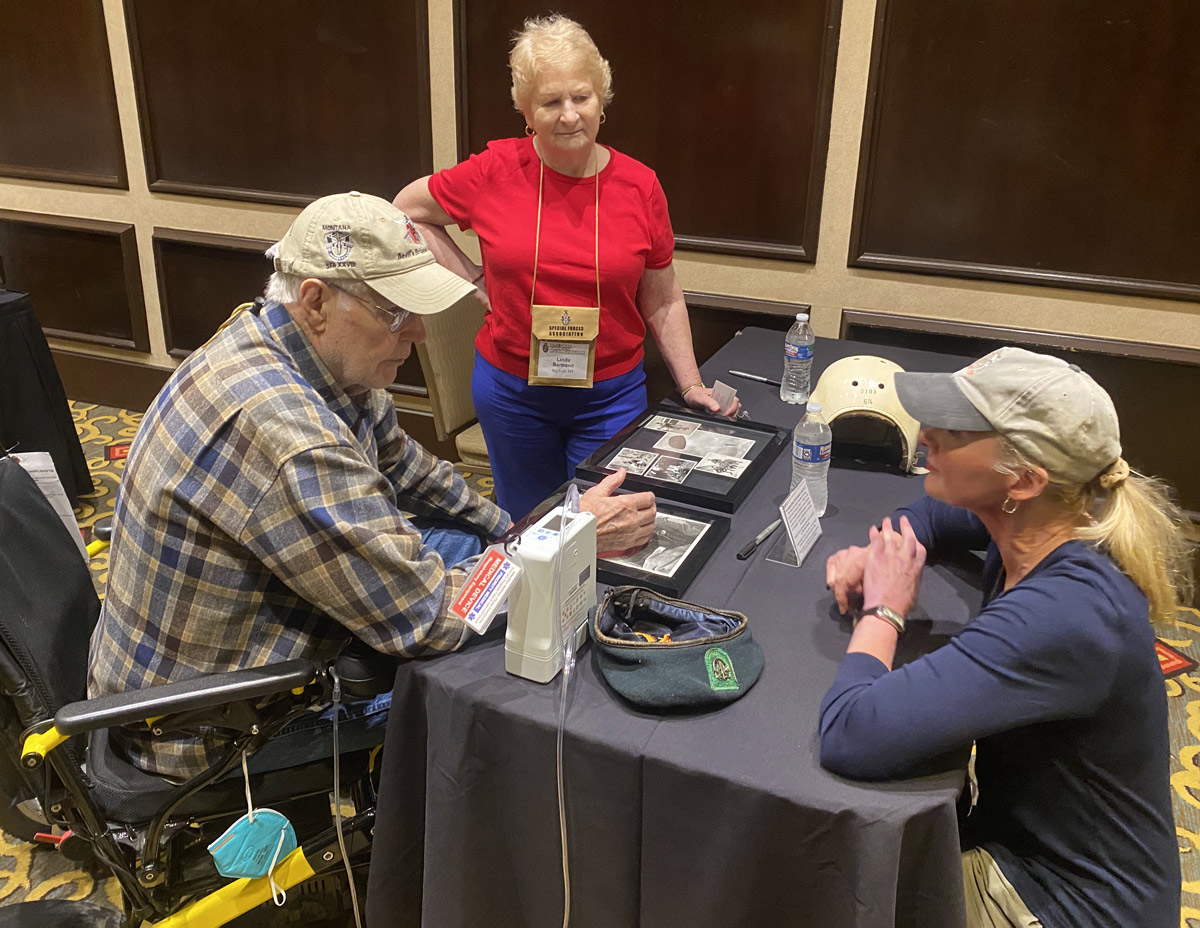
Left to right, SF Original Henry Bertrand and his wife Linda talk with Alex Quade about life lessons. (Courtesy Zeke Lloyd)
They shared “the gut stuff” — life-lessons and take-aways for the next generation of SF…
Just like rockstars, the Originals signed autographs for their fans after the show — in this case, SF memorabilia for convention attendees. As they did, I asked them about “the gut stuff” — some of their life-lessons and take-aways for the next generation of SF.
“Well, what I learned in Special Forces, and the people that I met, helped me to do the things that I do in business. And it has made me very, very successful. And all credit goes to the Special Forces organization,” Original Richard Simonian said, as he sat next to COL Aaron Bank’s jump helmet, which had Bank’s signature inside.
“I learned never to give up. Fight and keep fighting until you die. Yeah,” he added.
“Thank you, Richard,” I said, turning to talk with his fellow Originals. (As I did, he told the photographer, “She will never give up — this lady.” Coming from him, I take that as a compliment.)
Original Henry Bertrand sat next to some of his black-and-white photos and his green beret, which had a dragon embroidered on the inside.
“When I came in as SF, I was a 19-year-old kid. I thought I knew everything. I didn’t know anything. SF taught me so many things: how to be a good soldier, how to be a good person, how to relate to my brothers in the service. To me, it was an ongoing experience my whole life.
You have to understand that once you put that green beret on, that you actually wear it for life, whether you’re in service or out of service,” Henry Bertrand said.
And — the importance of family…
Henry Betrand keyed in on family…
“You have to remember, family for the SF soldier is very difficult, because you’re deployed, probably 8 or 9 months out of the year. And that has destroyed many families. I was married twice, before this beautiful lady showed up…” Henry looked at his wife, Ms. Linda.
So, I turned to her.
“He made the comment to me one day when I asked why he got a divorce. He said, ‘You have to realize my wives didn’t know where I was going when I left for work, whether I would be home, when I would come home. They had no knowledge of what I was doing when I came home, or where I had been. They were in the dark all the time. How can you keep a marriage together when you walk out the door, and they don’t know if you’re ever coming back?’ That was just something that hit me that was important,” Ms. Linda Bertrand shared.
“What’s your advice for this generation, and the next of SF spouses?” I asked her.
“You just have to keep in touch. Nowadays, you have a better way of keeping in touch. But you have to be strong, I think, as a wife — to know that man isn’t doing who-knows-what… there are things that aren’t important (for you) to know. (What you need to know is) that the thing he’s doing is very important to our country. And, you have to be very emotionally attached to your country, and believe in the military also,” Ms. Linda explained.
“Thank you, Ms. Linda,” I hugged her, “Your thoughts will help other spouses.”
Original Clyde Sincere also shared with me about family, and what Green Berets should consider…
“I have four sons. Three of them served in the military. And one was born here (Colorado Springs), before I retired. So he didn’t grow up in the military and he’s a businessmen today. But my 3rd son graduated from the Air Force Academy, and he was a fighter pilot for eight years and did his obligation,” Clyde began, as he sat next to various historical documents.
“When he got out, I actually cried. I was so hurt that he had left the service — because of my four sons I thought he was the smartest. So I approached him — and he, with icicles in his eyes, he pointed at me and said, ‘You were never home!’” Clyde Sincere admitted, looking sad.
His son became a stay-at-home Dad — homeschooling his children from grade school, until they went to college.
“So, when you come in SF, you have to be able to be ready for some away time from your family. And that could hurt, and I lived it. But yeah, that’s the downside,” Clyde said. “But I had such a great time. I had such great officers and NCOs.”
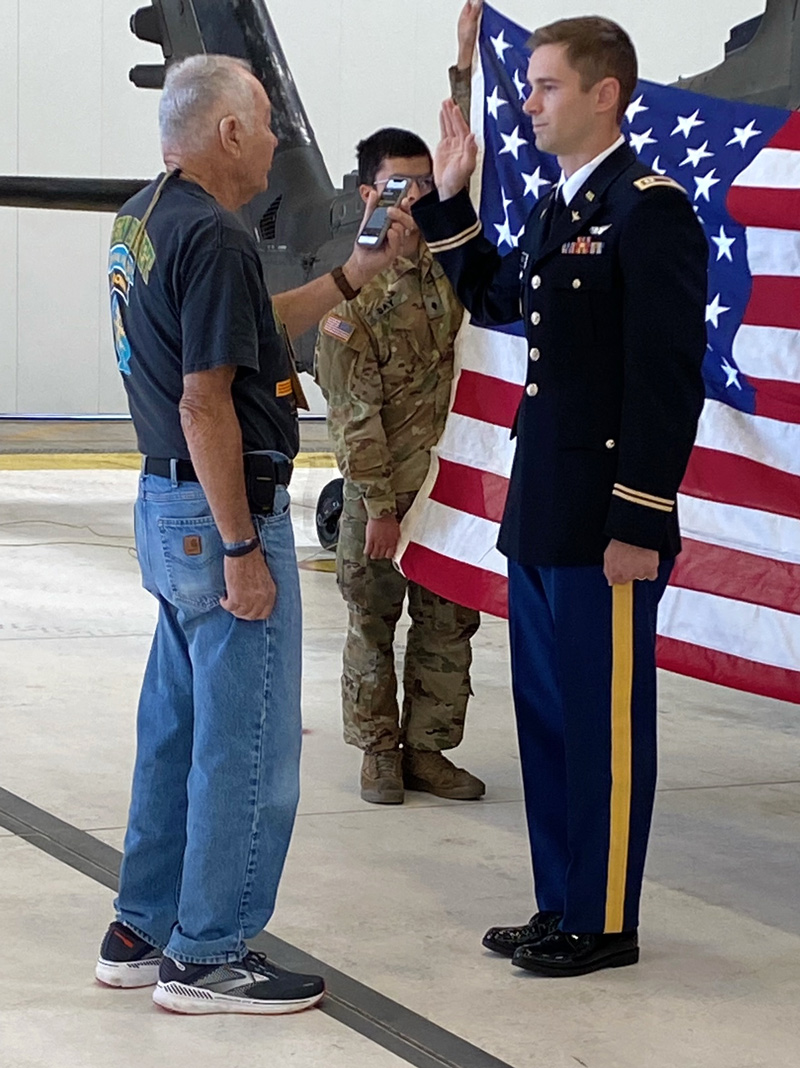
SF Original COL (r) Vahan Sipantzi administers Oath of Office to his grandson Nathan Sipantzi. (Courtesy Zoe Sipantzi)
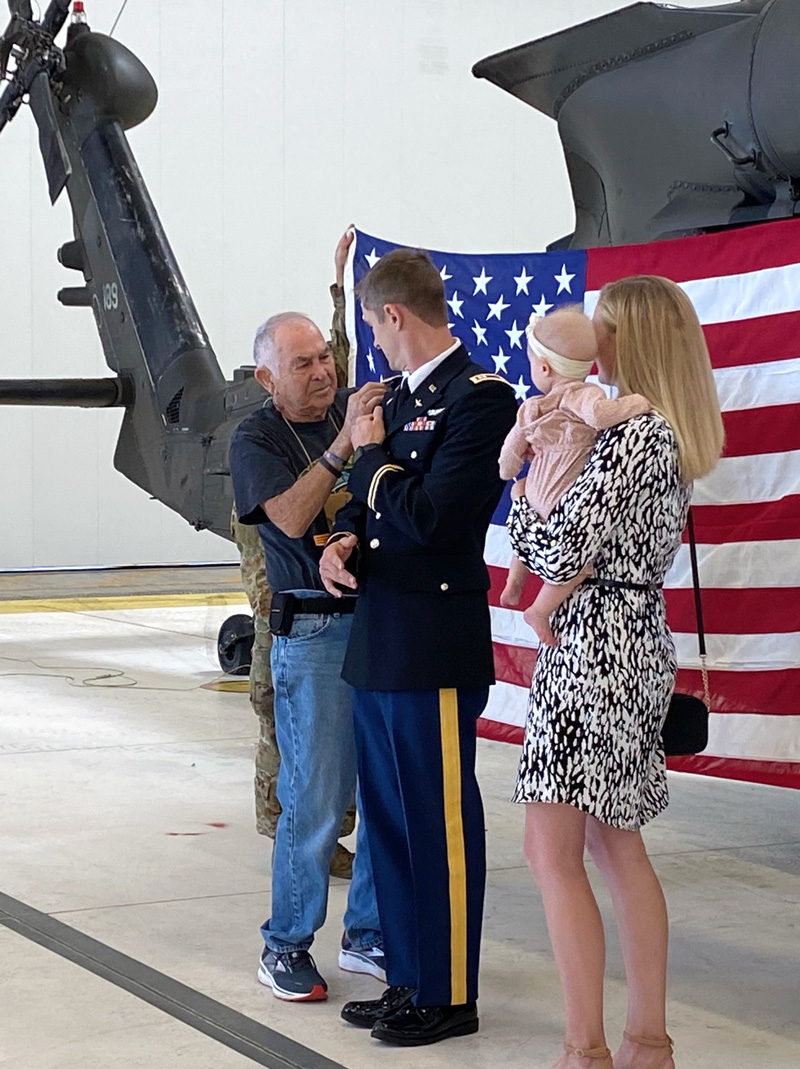
SF Original COL (r) Vahan Sipantzi pins CPT bars on his grandson, 1LT Nathan Sipantzi. (Courtesy Zoe Sipantzi)
Speaking of the importance of family…
Good thing I’d caught up with Original Vahan Sipantzi earlier, and had him sign those posters.
Because, while I’d been following up with his three buddies, he’d snuck off down the road to nearby Ft. Carson, “Home of The Originals.” (*His wife, Ms. Zoe kindly shared the photos shown below.)
There, COL (ret) and Chaplain Vahan Sipantzi pinned Captain’s bars on — and administered the Oath of Office to — his grandson, Nathan.
CPT Nathan Sipantzi’s father, Terri Sipantzi — was an A-team leader in the 10th Special Forces Group. The legacy of service — and the legacy of family — continues.
Reporter Alex Quade extends gratitude to everyone she quoted, and requested photos from. Special thanks: Zeke Lloyd, SSG Travis Fontaine, 10SFG PAO, COL Vahan & Ms. Zoe Sapantzi.
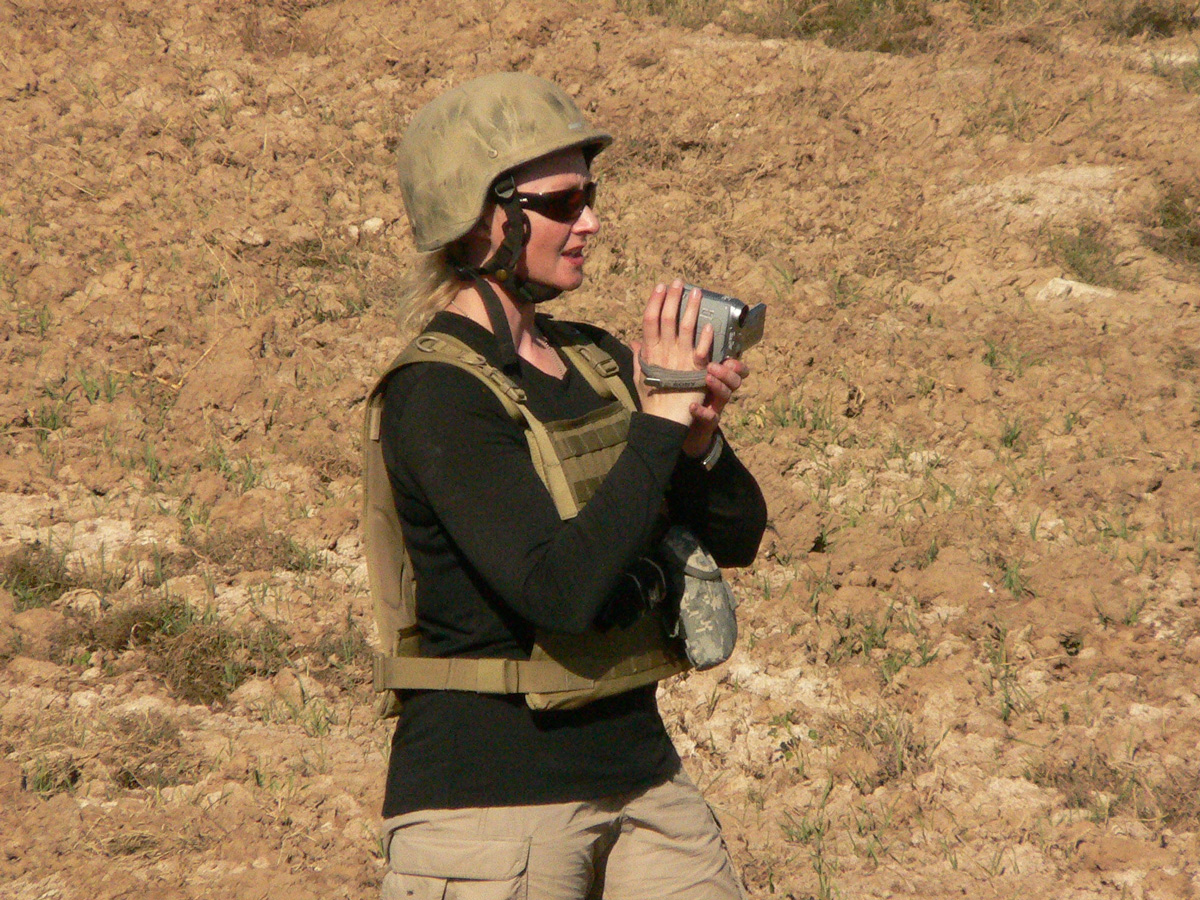
ABOUT THE AUTHOR — War reporter and documentary filmmaker Alex Quade started her career at the White House during the Persian Gulf War. She’s worked in television covering global conflicts and hostile environments for CNN, FOX, CBS, HLN, APTN and CNNI out of Frankfurt and Berlin, Germany, New York and Atlanta (Alex Quade’s filmography is available at https://m.imdb.com/name/nm6102772/fullcredits?ref_=m_nmfm_1). She’s produced videos and reports for The New York Times; front page stories for The Washington Times, Military Times, and Small Wars Journal; and magazine cover features for National Guard, Communicator, and Dangerous Assignments. She’s the recipient of more than two dozen journalism awards. Among them: two national Edward R. Murrow Awards, the national Defense Media Award for her career covering special operations, an International Aerospace Media Award, group Emmy, Peabody and Columbia du-Pont Awards, and the Congressional Medal of Honor Society’s Excellence in Journalism Award “for her courageous reporting and honest news coverage.” For more info or to contact Alex: http://alexquade.com/
I didn’t realize what a big shot you are!
Tony
Alex Quade’s accomplishments are indeed impressive!
I think it is great.that these men were honored at the 70th I also am proud to that 3 of these are friends